All About Visiting Yellowstone in September
The benefits, drawbacks, activities and other features of visiting Yellowstone in September.
Updated: 09/02/22
September is a spectacular time to visit Yellowstone National Park. The summer crowds begin to disappear, and you have a real chance for solitude and phenomenal wildlife viewing. There are many benefits to visiting in September and some drawbacks. Read through the categories below to determine if September is the best time for you to visit the park!
Benefits of Visiting in September
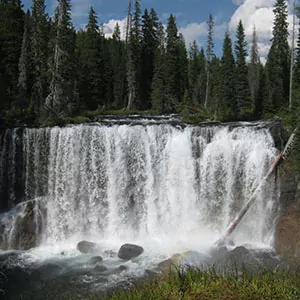 The biggest benefit to visiting in September is the lack of crowds. September marks the official end of summer tourism, so there are a lot fewer people in the park. While the park will not be as empty as it will be later in the fall, the traffic lines will be substantially lessened, especially after kids have returned to school for the fall. Accommodations will be readily available and less expensive than during peak season, making visiting and staying inside the park less stressful and more affordable.
The biggest benefit to visiting in September is the lack of crowds. September marks the official end of summer tourism, so there are a lot fewer people in the park. While the park will not be as empty as it will be later in the fall, the traffic lines will be substantially lessened, especially after kids have returned to school for the fall. Accommodations will be readily available and less expensive than during peak season, making visiting and staying inside the park less stressful and more affordable.
Without the long lines of traffics and incredibly crowded famous sights, the park is much more enjoyable in September and is a great shoulder season to visit Yellowstone. Additionally, the fall colors are abundant at the end of the month. Most of the park is made up of lodgepole pines, which don’t change colors with the season, but there are many pockets of aspen trees throughout the park. Their bright yellow leaves shimmer in the sunlight and are a treat for visitors in autumn.
Another benefit of September is wildlife viewing, as it is mating season for species in the park. Elk move north to areas like Mammoth Hot Springs and the Madison River for their mating, called the rut. Bull elk are often seen defending and fighting for their harem, and their bugling can be heard echoing off the mountainsides. This iconic elk call- varying from a high pitch whistle to a low, almost growling sound- is quite a wonder to hear in the park. Many visitors see the bull elk clashing against one another, fighting for harems of females, their antlers interlocked as they but against each other.
It is also the mating season for Bison in the Hayden and Lamar Valleys. Instead of forming harems, both male and female bison all remain in a large herd, with the bulls clashing with their horns and the winner taking a female aside to mate before returning to the herd. These massive groups of animals are remarkable to see, but make sure to stay 25 yards away from all animals to avoid being perceived as a threat.
September is also a phenomenal month for hiking and backpacking Yellowstone! The bugs are gone, the crowds are mostly gone, temperatures are still fall-like, and the backcountry is ripe for exploring. With permits easier to get ahold of with fewer crowds, the backcountry is remarkable in September as the fall colors are gorgeous, the wildlife is abundant, and the solitude is refreshing and peaceful. Fishing season is still open during this month, and the trout are beginning to bite again as the weather cools, so grab a fishing license and your rod before heading out to try your hand in one of the many rivers and lakes.
Drawbacks of Visiting in September
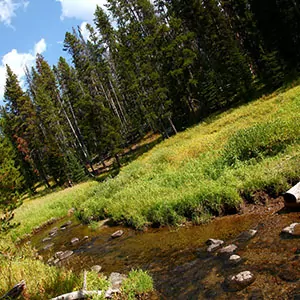
The biggest drawback to visiting the park in September is that some facilities, including campgrounds and lodging, begin to close throughout the month. Many remain open, but Lake Lodge and Roosevelt cabins close at the beginning of September, and Old Faithful Lodge and Grant Village close at the end of the month. Boating on Yellowstone Lake also closes near the beginning of the month. You can read Yellowstone Lodging’s closing dates before planning your accommodations. So while the crowds are lessened in September, the closure of additional accommodations has the potential to make the ones that are still open closer to capacity than they might be otherwise.
The weather in September can be either a benefit or a drawback, depending on the year. Snow over labor day weekend is not unheard of, but neither are temperatures in the high 70s. Many guests enjoy the cooler weather that fall brings as a relief from the warm summer, but September is not to be underestimated, even if adverse weather is uncommon. Pack layers! An unexpected snowstorm or other adverse weather, such as flooding, can cause unexpected road closures.
Things To Do In September
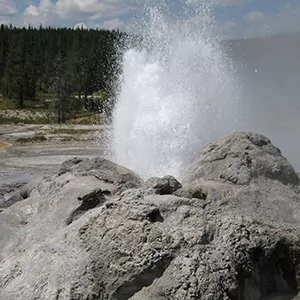 September is fantastic for sightseeing in Yellowstone. Hydrothermal feature activity does not vary throughout the seasons, but fewer visitors ensure viewing these features is even more magical. Sit back at Old Faithful or wander around the sparely populated boardwalk to see these vents, geysers, and springs steaming, spewing, and bubbling.
September is fantastic for sightseeing in Yellowstone. Hydrothermal feature activity does not vary throughout the seasons, but fewer visitors ensure viewing these features is even more magical. Sit back at Old Faithful or wander around the sparely populated boardwalk to see these vents, geysers, and springs steaming, spewing, and bubbling.
Wildlife viewing is also popular in September. Both bison and elk are mating this time of year, which provides excellent opportunities to see them in most areas of the park. The elk gather near Mammoth Hot Springs, while the bison are generally in the Lamar and Hayden Valleys. Bears are still out and about for the season and can be seen beginning to put on fat stores for the coming winter. In September, wolves return to lower elevations as the temperature drops, the low country becomes comfortable, and their prey has moved to the valleys to mate. Yellowstone is the best place in the United States to see wolves, and the best time is between dawn and dusk in Lamar Valley.
Both hiking and backpacking are world-class in September, and most of the trails are still available even at higher elevations where snow hasn’t fallen. Aspen trees glisten gold in the autumn light, turning even a short hike into something special. There are a variety of trails in the park– over 1,000 miles worth, in fact– a trail for every experience level. From short strolls along a boardwalk or the shores of Yellowstone Lake to mountain treks up to one of the many peaks or into the backcountry, you won’t regret getting out on the trails.
Fishing is great in many of the rivers in September; as the water cools, the trout are beginning to bite again. The Madison River and Gardner and Yellowstone Rivers are great options for fishing when it’s cooler. Night and star photography are very popular options, as the nights are not as cold as later in the fall.
There are plenty of options if the weather prevents you from being outside, even if it’s just a heavy rain storm. Many bus tours go around the park, allowing visitors to view different parts of the park from the comfort of a heated bus. A variety of visitor centers in different villages throughout the park, many of which have museums that provide excellent interpretive information about the park and the surrounding region and historical information about its indigenous and volcanic past. Outside the park’s west entrance lies the Grizzly and Wolf Discovery Center, an accredited, nonprofit zoo that houses grizzly bears and wolves and lets you see these amazing creatures that live in the park up close.
Things to see in September
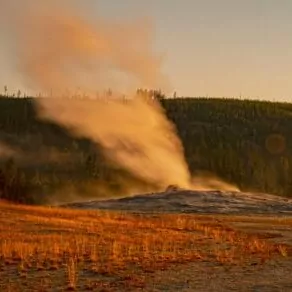 Yellowstone is full of sights to see in September; below is a list of some of the most popular.
Yellowstone is full of sights to see in September; below is a list of some of the most popular.
Old Faithful: No matter how many times you’ve seen it, you have to stop and see Old Faithful on a visit to Yellowstone, the most famous geyser in the world. While many geysers are unpredictable and do not erupt frequently, Old Faithful has lived up to its name and has only varied in eruption time by 30 min in the last 30 years. You will surely be wowed at this iconic Yellowstone geyser that spews hundreds of gallons of boiling water 130 ft in the air.
Grand Prismatic Spring: Know for its vast size and rainbow-colored water, Grand Prismatic Spring is Yellowstone’s largest and one of the most acidic hot springs. Filled with billions of microorganisms that give the waters their color, this spring provides guests with a boardwalk area and an overlook trail. Hold onto your hats, though, as this area is always windy.
Norris Geyser Basin: The oldest, hottest, and driest of the geyser basin in the park, Norris Geyser Basin should definitely be on your list of must-sees. This basin is full of many geysers and is home to the tallest geyser in the world: Steamboat Geyser, which spews water 300-400 ft in the air. With fewer crowds and an extensive boardwalk system, you won’t want to miss this amazing collection of hydrothermal features.
Fall Colors: While Yellowstone has many evergreen trees, such as the lodgepole pine that blankets many of the mountains in the park, some trees change color with the season and are a treat for the visitors to see. Golden aspens, red-brown shrubs, and bright yellow grasses in the valleys give the park signature warm fall colors that are so characteristic of this season.
Mammoth Hot Springs: This area is a must-see in September for more than one reason. The hot springs are unlike any others in the park, built on terraces of white and burnt orange that have been described as more beautiful than any fountain man could design. The Mammoth area is where many of the elk congregate for the rut, their mating season. Visitors will hear the classic bull elk bugle in this area and may even catch a glimpse of elk head butting with interlocked antlers, fighting for females.
Llama Treks in setpember
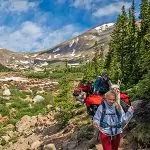 Llama treks are fantastic in September and offer the ability to explore the backcountry of Yellowstone with minimal impact and maximum comfort. Each llama can carry 70 pounds of gear and supplies so that guests can hike with light day packs. Options range from 3-day- to 6-day trips and feature waterfalls, wildlife, vast meadows, and stunning scenery. If you’d like to enjoy the benefits of a llama trek but aren’t interested in a fully guided adventure, you can also rent llamas or hire Wildland Llamas to provide a drop camp for you, which is a service where the outfitter carries in your supplies and helps set up your camp but do not provide a guided trip.
Llama treks are fantastic in September and offer the ability to explore the backcountry of Yellowstone with minimal impact and maximum comfort. Each llama can carry 70 pounds of gear and supplies so that guests can hike with light day packs. Options range from 3-day- to 6-day trips and feature waterfalls, wildlife, vast meadows, and stunning scenery. If you’d like to enjoy the benefits of a llama trek but aren’t interested in a fully guided adventure, you can also rent llamas or hire Wildland Llamas to provide a drop camp for you, which is a service where the outfitter carries in your supplies and helps set up your camp but do not provide a guided trip.
Some people wonder why Wildland Trekking uses llamas instead of horses on our all-inclusive trips and offers llama rentals. Llamas are fantastic stock animals for many reasons, and many people believe they are better than even horses. The largest difference is that you lead a llama instead of horse riding. Some people see this as a benefit, and some see it as a drawback. Llamas have other benefits, such as being able to handle more technical terrain, having a lesser impact on the environment, having easy temperaments that are less prone to spooking, and serving as camp guards. Many guests have found that llama’s quirky personalities provide enjoyable company to hikers.
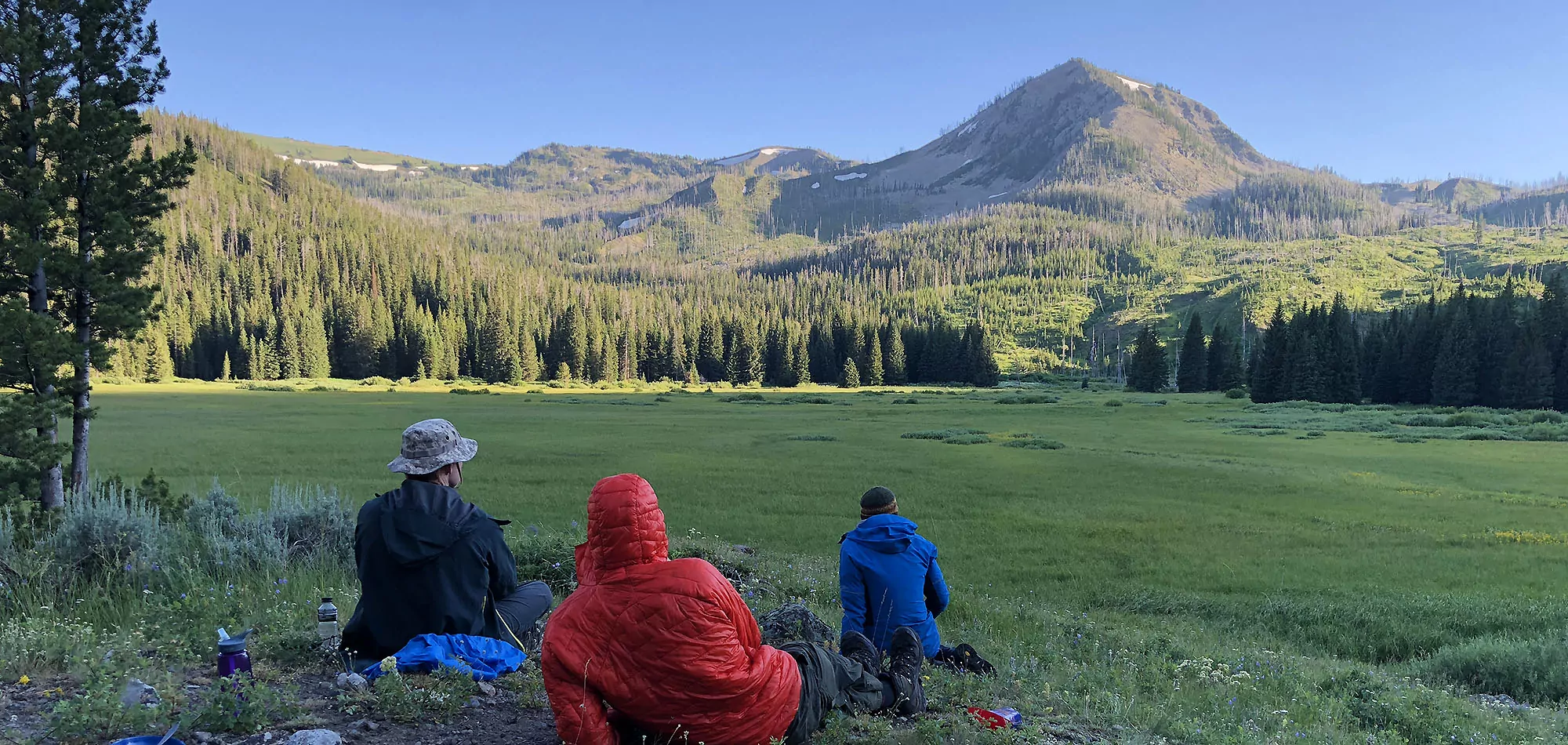
Hiking in September
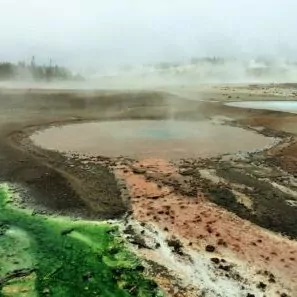 Hiking is ideal in September with the abundant autumn foliage, the bison and elk rutting, and the cooler temperatures. Fewer people are in the park this time of year so visitors can experience solitude during time spent in nature. Visitors will likely find fewer crowds and more enjoyable walking in September than earlier in the year.
Hiking is ideal in September with the abundant autumn foliage, the bison and elk rutting, and the cooler temperatures. Fewer people are in the park this time of year so visitors can experience solitude during time spent in nature. Visitors will likely find fewer crowds and more enjoyable walking in September than earlier in the year.
Most of the geyser basins have boardwalks within the 1 to 2-mile range that are entirely flat and perfect for those who want a leisurely stroll around some of the park’s most astonishing features. Norris Geyser Basin and Upper Geyser Basin, where Old Faithful lies, are great options for short walks among these astonishing hydrothermal features. The shores of Yellowstone Lake are a great option if you are looking for a flat walk that you can make as long or as short as you want. If you’re looking for something a little bit more challenging, hiking around the Grand Canyon of Yellowstone is a great choice, with the Seven Mile Hole Trail and the Red Rock Point Trail both great options. There is also walking along the rim of the canyon that will bring you to many of the viewpoints that give you views of Yellowstone Falls.
Many trails branch off from famous sights up to overlooks where you can see these areas from a different angle. Old Faithful has a fantastic short hike that leads you up to an overlook where you can see many of the geysers in the basin. Grand Prismatic Spring also has an overlook trail that can be continued on a hike up to Fairy Falls, a stunning sight. There are heaps of hiking in the Lamar Valley, where you can see wildlife and stunning scenery in this lowland paradise. Wildlife can be seen in this valley, such as big horn sheep, mountain goats, and pronghorn, along with bison and elk. Patient visitors may also get a glimpse of one of Yellowstone’s resident wolf packs.
Wildlife and hydrothermal features pose threats to those even out on day hikes, so it is best to give both of these a wide berth as animals may be aggressive if approached, and hydrothermal areas may not have boardwalks that make walking among the features safely. The biggest danger to hikers, however, is weather. The weather can change quickly and violently as the park moves toward late fall and winter. Afternoon thundershowers are not uncommon, and the temperature drops quickly after the sun goes down. Hypothermia is a very real danger even if the temperature is not below freezing. Most cases of hypothermia in the park occur when the temperature is between 30° and 50°F. Carry rain gear and warmer layers, and make sure to put on those layers before you get wet and/or begin shivering. Be aware of ice on the trails/roads if it has rained in the past day, as below-freezing temperatures overnight may have frozen the rainwater and created slippery conditions.
Backpacking in September
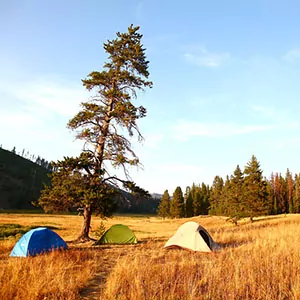 Backpacking is incredible in September, and permits are easier to obtain in the fall as the crowds thin. Spending the night under the golden aspens and brilliant stars in Yellowstone National Park is unbeatable. Few visitors to the park can venture into the backcountry to immerse themselves in the wilderness, so take advantage of this opportunity if you have it. Even though the park is moving toward fall and winter, the chance of snow in September is low, so backpacking trips are equitable to summer. The nights are on the chilly side, and you might encounter heavy rain storms and high winds.
Backpacking is incredible in September, and permits are easier to obtain in the fall as the crowds thin. Spending the night under the golden aspens and brilliant stars in Yellowstone National Park is unbeatable. Few visitors to the park can venture into the backcountry to immerse themselves in the wilderness, so take advantage of this opportunity if you have it. Even though the park is moving toward fall and winter, the chance of snow in September is low, so backpacking trips are equitable to summer. The nights are on the chilly side, and you might encounter heavy rain storms and high winds.
With hundreds of miles of trail to choose from, there will surely be a backpacking itinerary that fits your desires. Whether you are looking for fishing and pristine lakes and rivers, wildlife viewing and low-lying meadows, or mountain peaks and deep canyons, Yellowstone has everything you could want out of a backpacking trip. A popular option is a backpacking trip from Heart Lake to Snake River that includes geothermal vents without the boardwalk or the crowds, gorgeous lakeside camping, great opportunities to see wildlife, and the majestic Snake River. This trip is at minimum four days but can be made longer if you want.
Of course, backpacking in Yellowstone, even at the most optimal season, does come with some inherent risks. Bear country requires visitors to hang their food or bring approved bear-resistant containers to keep bears away from human food. Follow good bear country safety guidelines. If you aren’t familiar with camping, hiking, and cooking in bear country, read up on it or consider going with a guiding company that will brief you on procedures and provides appropriate gear.
Weather in September
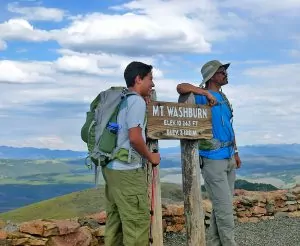 Yellowstone is a very large park with a wide range of elevations, so the weather you experience will depend greatly on where you are and what elevation you are at. Generally, the weather in September in Yellowstone is variable, with warm days and chilly nights. The average temperature for Mammoth Hot Springs is a high of 68 and a low of 39 degrees Fahrenheit (20/ 4 degrees Celsius). At Yellowstone Lake, the average high is 61, and the low is 31 degrees Fahrenheit (16/ -1 degrees Celsius). It usually rains five days in September. Please note that these numbers are only averages, and the park can receive much warmer or colder temperatures than this in September. Always check the weather in the specific area of the park you are planning on visiting.
Yellowstone is a very large park with a wide range of elevations, so the weather you experience will depend greatly on where you are and what elevation you are at. Generally, the weather in September in Yellowstone is variable, with warm days and chilly nights. The average temperature for Mammoth Hot Springs is a high of 68 and a low of 39 degrees Fahrenheit (20/ 4 degrees Celsius). At Yellowstone Lake, the average high is 61, and the low is 31 degrees Fahrenheit (16/ -1 degrees Celsius). It usually rains five days in September. Please note that these numbers are only averages, and the park can receive much warmer or colder temperatures than this in September. Always check the weather in the specific area of the park you are planning on visiting.
While September is usually warm and is typically closer to summer in weather than it is to fall or winter, the weather can still be variable and change quickly; afternoon thundershowers and high-velocity wind storms are not uncommon, and visitors should be prepared with the appropriate clothing and gear. September can be chilly during the evenings, and the temperature drops rapidly after the sun goes down, so bring warm layers and rain gear, especially if you are camping or planning on outdoor activities after dark.
Wildlife in september
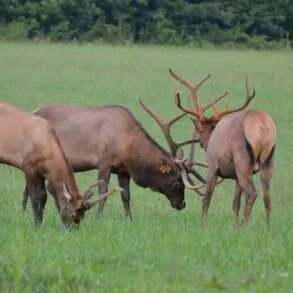 September is wonderful for viewing wildlife in Yellowstone as both the elk and bison are in the middle of the rut, their mating season. This brings vitality and action to the wildlife scene and drives many naturalists and photographers from all over to witness this amazing season. Elk typically gather in the area around Mammoth Hot Springs, where bull elk form their harems of 10 to 30 females. The smaller herds are separated from others, and male elk can be seen interlocking antlers with other males fighting over mates. The characteristic elk bugling during this time can be heard from miles away and often echoes in the mountains.
September is wonderful for viewing wildlife in Yellowstone as both the elk and bison are in the middle of the rut, their mating season. This brings vitality and action to the wildlife scene and drives many naturalists and photographers from all over to witness this amazing season. Elk typically gather in the area around Mammoth Hot Springs, where bull elk form their harems of 10 to 30 females. The smaller herds are separated from others, and male elk can be seen interlocking antlers with other males fighting over mates. The characteristic elk bugling during this time can be heard from miles away and often echoes in the mountains.
Bison are also in their meeting season, but these animals often gather in the Lamar and Hayden Valleys. Instead of forming small herds like elk do, bison remain in large herds, with the bulls fighting each other nearby and the winner taking a female away from the group to mate before returning. These large groups are wonderful to see, and the tussles between males of both species are impressive. Mating season can make them more aggressive and territorial than usual, so give them their space.
Yellowstone is home to many elusive animals that visitors rarely see. Mountain lions, bobcats, wolverines, badgers, red foxes, Canadian lynx, beavers, and river otters all live in the park, but take more patience to see compared to the iconic elk and bison. If you’re interested in seeing some of these animals, talk to a ranger about where the best place and the best time to see other species and do some research online to see where you might encounter your particular animal.
RECOMMENDED Wildland trips in september
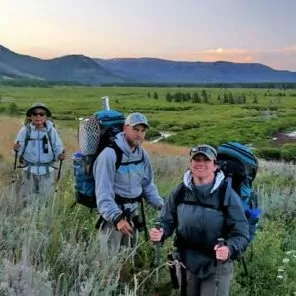 Planning a trip to Yellowstone in September can be a headache as you try to keep up with what accommodations are open and available, what the conditions will be, and what weather you need to pack for. But you can bypass all that headache by booking a trip with Wildland Trekking and letting one of our expert guides show you around the park. September is an excellent time for backpacking and llama treks, but we offer a variety of trips, from the comfort of inn-based tours to base camp trips and day hikes. And as a bonus, all of our trips are all-inclusive, so you don’t have to worry about meals, local transportation, much of your gear, or any logistics, as we’ll take care of all of that for you. There is truly something for everyone here, so feel free to explore all the trips we offer in Yellowstone. Here are a few we especially recommend for September.
Planning a trip to Yellowstone in September can be a headache as you try to keep up with what accommodations are open and available, what the conditions will be, and what weather you need to pack for. But you can bypass all that headache by booking a trip with Wildland Trekking and letting one of our expert guides show you around the park. September is an excellent time for backpacking and llama treks, but we offer a variety of trips, from the comfort of inn-based tours to base camp trips and day hikes. And as a bonus, all of our trips are all-inclusive, so you don’t have to worry about meals, local transportation, much of your gear, or any logistics, as we’ll take care of all of that for you. There is truly something for everyone here, so feel free to explore all the trips we offer in Yellowstone. Here are a few we especially recommend for September.
The Thorofare: If you’re looking for a long-distance backpacking trip in the heart of Yellowstone’s wilderness, then this is the trip for you. Venture into the headwater basin of the Yellowstone River, the US’s longest undammed river, and experience the heart of the backcountry like never before on this 7-day/6-night adventure. With opportunities for wildlife viewing, fishing, pristine wilderness, and amazing views, this is an adventure you won’t want to miss out on.
Heart Lake Llama Trek: Llama tracks are a great way to venture farther into the wilderness with a lighter pack on your back, and this trip is no exception. Enjoy this six-day adventure in Yellowstone’s backcountry with a summit of Mount Sheridan, spectacular solitude, and a traverse down Snake River to Heart Lake, all the while accompanied by your amazing animal companions and an expert guide.
Best of Yellowstone Inn-Based Tour: The perfect mix of luxury and rustic, this inn-based trip is your way to see all the distinct places of Yellowstone national park without the headache of planning your own itinerary. Each day the group will set out on a day hike in a different area of the park, distinct from the previous day, before settling down in your cozy national park lodge accommodations for the evening. With fewer crowds in September, this tour is a great way to see the best parts of the park.
Yellowstone Basecamp Tour: If you’re looking to hike and camp but are not sure you want to get into the backcountry without amenities, this base camp tour is a great option. This 5-day tour will allow you to explore great swaths of the park on numerous day hikes while knowing you have a cozy camp, comfortable sleeping accommodations, and a warm fire to return to you in the evening. Experience the spectacular sites and sleep under the stars on this remarkable base camp tour.
Join a Guided Hiking Adventure
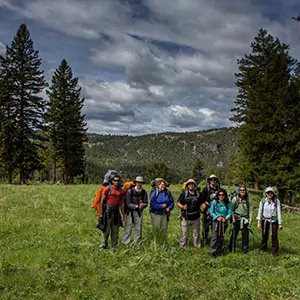 Yellowstone National Park is home to some of the most epic and amazing hiking vacations in the world. Wildland Trekking offers trips with the best of Yellowstone: geysers, waterfalls, views, wildlife, solitude, adventure, and fascinating natural and cultural interpretation.
Yellowstone National Park is home to some of the most epic and amazing hiking vacations in the world. Wildland Trekking offers trips with the best of Yellowstone: geysers, waterfalls, views, wildlife, solitude, adventure, and fascinating natural and cultural interpretation.
Guided Yellowstone treks are all-inclusive, covering permits; local transportation (excluded on specific tours); meals; equipment; safety systems, and professional hiking/wilderness guides, allowing visitors to maximize their time in Yellowstone and focus entirely on enjoying the Park.
YELLOWSTONE ADVENTURE TOURS
- GUIDED BACKPACKING ADVENTURES: these are for people interested in an authentic Yellowstone adventure away from the roads and crowds.
- LLAMA TREKS: on these innovative trips, guests hike with light day packs and camp near stunning backcountry locations.
- INN-BASED PACKAGES: these tours are all-inclusive packages with lodging, amazing daily hikes, expert guides, meals, transportation, and more!
- CAMPING-BASED HIKING PACKAGES: camping-based hiking packages provide all-around hiking experiences of Yellowstone on wonderful outdoor vacations.
- DAY HIKE TOURS: maximize your day in Yellowstone on a fully guided, award-winning hiking tour on one of the Park’s best trails.





